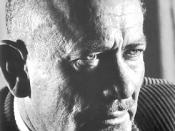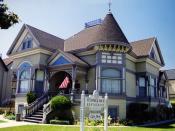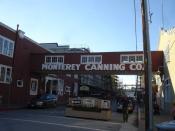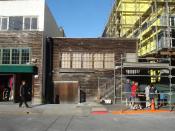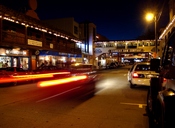Literary Review: John Steinbeck's Cannery Row The adventurous and unemployed group of Mack and the boys (Hazel, Eddie, Hughie and Jones) who live in a fish-meal shack on Cannery Row decide that they should do something nice for Doc, the owner of a biological studies supply house. They plan to give Doc a party and give him a bunch of frogs to repay Doc for the numerous times he has helped each and every one of the group. Though their party turns out to be a complete disaster, after Cannery Row goes through a period of depression and influenza the people of the Row begin to feel better and happier. Mack and the boys throw a very successful "surprise"ÃÂ birthday party for Doc which everyone attends, including Lee Chong the grocery man, Dora and the girls from the whore house, Henri the painter, Gay and Mr. and Mrs. Malloy; the morning following the party Doc awakens and reflects on life as all returns to normal on Cannery Row.
Unlike many great classic novels, Cannery Row does not have a large, complex plot. Rather, Steinbeck uses deep and concrete descriptions and detailed accounts to create a very realistic setting and lifestyle. Though the storyline is simple, the main focus of the novel is on the emotions and interactions of a group of people in the cannery quarter of Monterey. Steinbeck marvelously depicts a realistic scene in which he precisely paints each character and gives substantial background to each one of them so that the reader has a panoramic view of Cannery Row. Steinbeck's use of description, characterization and his sage choice in setting make Cannery Row a masterpiece.
John Steinbeck's Cannery Row is set directly following the Great Depression in the cannery quarter of Monterey, near the Salinas valley in northern California where he grew up. His choice of setting for this novel sets the tone for the characters and the story. Having had first-hand experience with the place and the times in which the book is set, Steinbeck uses his background to shape the characters and make the story realistic. In doing this, he gives the reader a sense of the lifestyle and ways that were still affected by the Depression even after it had passed.
The characters that Steinbeck creates in Cannery Row are made powerful through good, strong description. He introduces each character or group, and then, using a number of brief side stories and diversions, describes events and happenings that broaden the character and reveal more of his personality. Through omniscient narrative, Steinbeck describes each one in great detail. The reader knows more of Henri than his physical appearance and daily life; Steinbeck tells even more about him being a painter, and the reasons why he never will finish the boat that he has already been working on for the past ten years. However, many of the things Steinbeck writes in his diversions do not openly describe the character; instead, each side story infers a general trait of a character. For example, in describing Mack and the boys, Steinbeck writes, "In addition to the big red chicken there was a sack of carrots which had fallen from a vegetable truck, half a dozen onions which had not."ÃÂ Humorously, this infers that in search of food the boys sometimes steal and are dishonest. Steinbeck's depictive descriptions as well as his use of informative diversions create well-rounded, full characters.
The best aspect of Steinbeck's writing is his great ability to describe something so specifically and precisely that a reader can picture it. His spatial organization is very precise. When Steinbeck describes Lee Chong's grocery, he tells of the myriad foodstuffs and living necessities stored in the shop, what happens in Lee's store, and the background behind everything in the store. In addition, he explains the vacant lot to the left of the store, Dora's bordello further down left, Doc's Western Biological supply house across the street, and the Palace Flophouse and Grill behind the store, all in great detail. Such an abundance of description adds to the broad portrait that Steinbeck illustrates of Cannery Row. No detail is too insignificant to be put in. To enhance these descriptions, he uses the anecdotes and diversions to create more background behind each person and place, like how Alfred came to be the bouncer at Dora's and how the Abbeville building became Lee Chong's and later the Flophouse. These descriptions create a sense of the lives of people on Cannery Row.
Though not much of a plot exists in Cannery Row, very little else is lacking within the novel. Steinbeck's expert use of description and characterization make Cannery Row a very worthwhile book to read. Using a profusion of deep detail and description, Steinbeck fully illustrates characters, lays out the setting for the story and paints a broad, yet clear portrait of Cannery Row.
